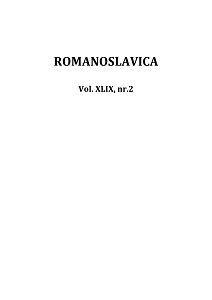Imaginea fraților misionari Chiril și Metodie în publicațiile și manualele de istorie publicate între 1830 și 1900
The image of the missionary brothers Cyril and Methodius in history publications and textbooks published between 1830 and 1900
Author(s): Armand GuţăSubject(s): Education, Cultural history, History of Church(es), Local History / Microhistory, Recent History (1900 till today), Romanian Literature, 19th Century, Eastern Orthodoxy, Translation Studies
Published by: Editura Universităţii din Bucureşti
Keywords: Cyril and Methodius Personality; Romanians Scholars; Historic Books and School Manuals;
Summary/Abstract: During the 19th and 20th century in Romania were discovered many historic documents about Cyril and Methodius missionary activity which were translated, adapted and published by several Romanians scholars like: B. P. Hașdeu, A. D. Xenopol, M. Ștefănescu, I. Bărbulescu , Ioan Bogdan, P. P. Panaitescu, P. Olteanu și Damian P. Bogdan. Romanian Scholars working within the different scientific field must have recognized the importance of these Slavic-Romanian documents, for that they were in a position to offer much importance according to a national scale and were therefore able to attract other specialists who have considerable expertise in their field. In spite of all linguistics and historic studies about the apostle Cyril and Methodius and their missionary activity among Central and East European Slavs and even Romanian population there are several other scientific sources. But, all these studies were based upon old theological, historic documents and books so that in this short essay we intend to underline some aspects of a particular issue of the image/personality of the two byzantine missionaries Cyril and Methodius and how they were also mentioned into Romanian historic and school manuals published between 1830 and 1900. During our researching work into Romanian Academy Library we have found several books in which were mentioned the two missionary brothers. These books are especially about Romanian early medieval history but there we found some very interesting information about our researching aims. For actual researching field, few things are more important than reevaluating old researching studies, but we can choose to have rather a different approach about this very interesting domain. In this essay, the information is refined and reinterpreted because its various structure, but before deciding where to interfere, we need to examine the differences between the two types of documents, particularly as regards the old linguist interpretation and scientific achievement. It is clear, therefore, that there are significant differences between the old theological and Slavic-Romanian documents and the schools manuals which may offer some pale advantages. The benefits of interpretation from so very different range of information presented in this type of modern documents must be great by the researching method itself. Despite some similarities, there are a number of marked differences in the way that linguist and historic researching methods operate. The range of subjects concerning into these school books and manuals is largely limited by the demands of the 19th century national curricula. In contrast, the old Slavic-Romanian documents can offer a greater choice of subjects, because they generally have more information, than schools manuals have. We intend to extract proper historic information that achieves somewhat higher academic standards.
Journal: Romanoslavica
- Issue Year: XLIX/2013
- Issue No: 2
- Page Range: 65-74
- Page Count: 10
- Language: Romanian

